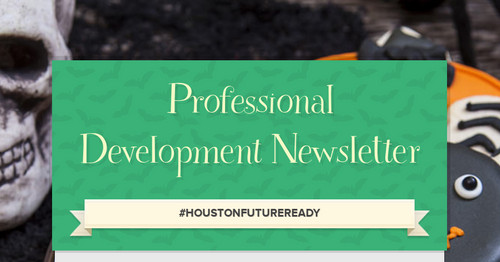
Professional Development Newsletter
#houstonfutureready
What is this newsletter about?
Testing Verbs
- analyze
- cite
- compare
- comprehend
- contrast
- describe
- evaluate
- explain
- identify
- infer
- interpret
- organize
- retell
- summarize
- synthesize
Upcoming Curriculum Work Days:
November:
13th-HS Math Day 3
14th-MS Math Day 3
15th-1st-2nd grades ELA Day 2
18th-3rd-5th grades ELA Day 2
21st-MS Social Studies Day 2
December:
5th-3rd-5th grades Math Day 2
6th-1st-2nd grades Math Day 2
9th-Kindergarten ELA/Math
11th-HS Science Day 3
12th-HS Social Studies/Foreign Language Day 3
Classroom Strategy to Increase Participation
One Classroom Strategy I love to use in my classroom is Think-Pair-Share. Think-Pair-Share (TPS) is a collaborative learning strategy in which students work together to solve a problem or answer a question about the assigned reading. This technique requires students to (1) think individually about a topic or answer to a question; and (2) share ideas with classmates. Discussing an answer with a partner serves to maximize participation, focus attention and engage students in comprehending the reading material.
Create and use the strategy:
- T : (Think) Teachers begin by asking a specific question about the text. Students "think" about what they know or have learned about the topic.
- P : (Pair) Each student should be paired with another student or a small group.
- S : (Share) Students share their thinking with their partner. Teachers expand the "share" into a whole-class discussion.
How to Build Relationships with Your Students
6 Great Strategies to Use in a Classroom
- VISUALIZATION: helps to bring concepts to life. Examples include: photos, audio clips, videos, field trips
- COOPERATIVE LEARNING: promotes students working together in a small group or whole class activity. Examples include: conducting science experiments, acting out drama sketches/plays, solving mathematical puzzles
- INQUIRY-BASED INSTRUCTION: helps students to ask and find answers to thought-provoking questions. Examples include: teachers asking questions and allowing students time to research, experiment, etc. to find the answer; can be math or science-driven (but NOT only limited to those subjects), is not just a worksheet; students are answering open-ended questions
- DIFFERENTIATION: teachers are allocating tasks based on student abilities to ensure all students are moving forward and not being left behind. Examples include: worksheets with varying degrees of complexity, work stations based on needs (may also be called centers), using iReady data (students are already grouped based on needs/abilities
- TECHNOLOGY IN THE CLASSROOM: students are able to use technology in various ways to promote engagement in the classroom and drive learning. Examples include: iReady use, Quizlet, using Google Classroom/Forms/Documents/Slides, Plickers, etc.
- BEHAVIOR MANAGEMENT: teachers are establishing routines and procedures to outline specific expectations to eliminate student confusion. Students know what is expected and the consequences if expectations are not met. Examples include: reward time, Fun Friday, etc. (based on meeting established expectations), classroom rules/procedures
Previous Month's PD Newsletter
Contact Information:
Philippians 4:9
Email: mward@houston.k12.mo.us
Website: https://www.houston.k12.mo.us
Location: 423 West Pine Street, Houston, MO, USA
Phone: (417)967-3024
Facebook: facebook.com/HoustonMOTigers
Twitter: @HoustonMOTigers






